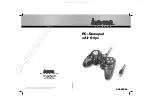
N60 NETWORK STABILITY AND SYNCHROPHASOR MEASUREMENT SYSTEM – INSTRUCTION MANUAL
8-1
N60 Network Stability and Synchrophasor
Measurement System
Chapter 8: Commissioning
Commissioning
This chapter outlines how to test frequency timing.
8.1 Testing
8.1.1 Testing underfrequency and overfrequency elements
Underfrequency and overfrequency protection requires techniques with subtle testing implications. Whereas most
protection is designed to detect changes from normal to fault conditions that occur virtually instantaneously, power
system inertia requires frequency protection to pick up while the frequency is changing slowly. Frequency measurement is
inherently sensitive to noise, making high precision in combination with high speed challenging for both relays and test
equipment.
Injection to a particular N60 frequency element must be to its configured source and to the channels that the source uses
for frequency measurement. For frequency measurement, a source uses the first quantity configured in the following
order:
1.
Phase voltages
2.
Auxiliary voltage
3.
Phase currents
4.
Ground current
For example, if auxiliary voltage and phase currents are configured, the source uses the auxiliary voltage, not the phase
voltages or any of the currents.
When phase voltages or phase currents are used, the source applies a filter that rejects the zero-sequence component. As
such, the same signal must not be injected to all three phases, or the injected signal is completely filtered out. For an
underfrequency element using phase quantities, the phase A signal must be above the
MIN VOLT/AMP
setting value.
Therefore, either inject into phase A only, or inject a balanced three-phase signal.
















































